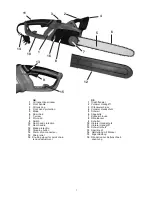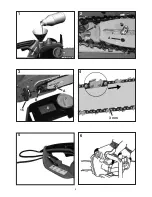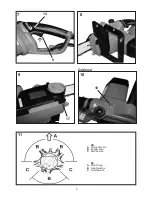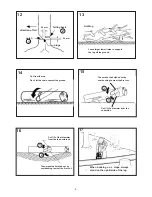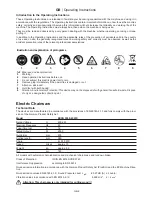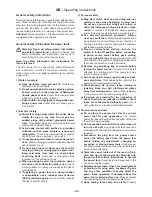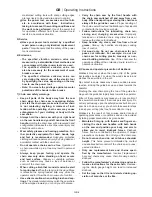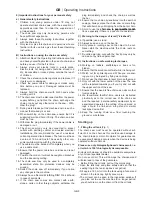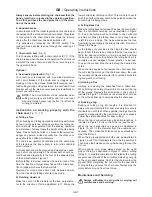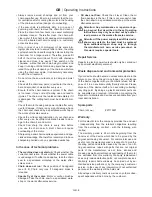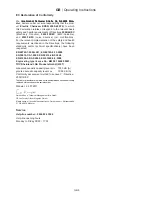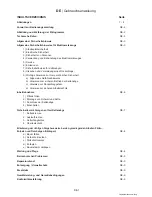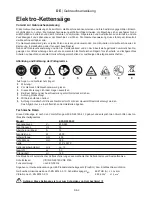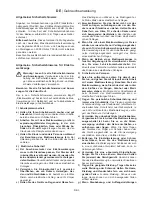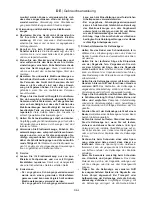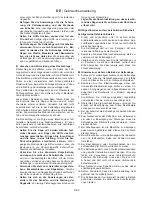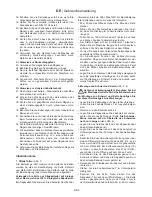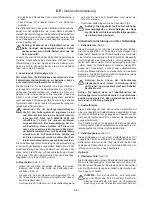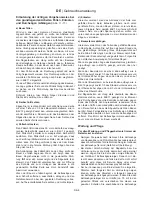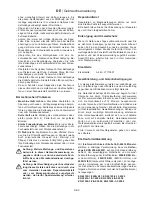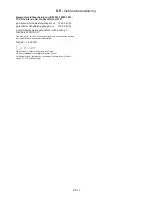
GB
|
Operating Instructions
GB-4
maintained cutting tools with sharp cutting edges
are less likely to bind and are easier to control.
g) Use the power tool, accessories and tool bits
etc. in accordance with these instructions,
taking into account the working conditions and
the work to be performed.
Use of the power tool
for operations different from those intended could
result in a hazardous situation.
5) Service
a) Have your power tool serviced by a qualified
repair person using only identical replacement
parts.
This will ensure that the safety of the power
tool is maintained.
6) Emissions
- The specified vibration emission value was
measured by a standardized test methods and
can compare with other power tools are used.
- The specified vibration emission value can
also be necessary for the assessment of work
breaks are used.
- The specified vibration emission value can
vary during the actual use of the electric tool
by specifying the value, depending on the way
how to use the power tool.
- Note: You create the privilege against vascular
pulsations of the hands in time breaks
7) Chain saw safety warnings:
• Keep all parts of the body away from the saw
chain when the chain saw is operating. Before
you start the chain saw, make sure the saw chain
is not contacting anything. A moment of inat-
tention while operating chain saws may cause
entanglement of your clothing or body with the
saw chain.
• Always hold the chain saw with your right hand
on the rear handle and your left hand on the front
handle.
Holding the chain saw with a reversed hand
configuration increases the risk of personal injury and
should never be done.
• Wear safety glasses and hearing protection. Fur-
ther protective equipment for head, hands, legs
and feet is recommended.
Adequate protective
clothing will reduce personal injury by flying debris or
accidental contact with the saw chain.
• Do not operate a chain saw in a tree.
Operation of
a chain saw while up in a tree may result in personal
injury.
• Always keep proper footing and operate the
chain saw only when standing on fixed, secure
and level surface.
Slippery or unstable surfaces
such as ladders may cause a loss of balance or
control of the chain saw.
• When cutting a limb that is under tension be alert
for spring back.
When the tension in the wood fibres
is released the spring loaded limb may strike the
operator and/or throw the chain saw out of control.
• Use extreme caution when cutting brush and sap-
lings.
The slender material may catch the saw chain
and be whipped toward you or pull you off balance.
• Carry the chain saw by the front handle with
the chain saw switched off and away from your
body. When transporting or storing the chain saw
always fit the guide bar cover.
Proper handling of
the chain saw will reduce the likelihood of accidental
contact with the moving saw chain.
• Follow instructions for lubricating, chain ten-
sioning and changing accessories.
Improperly
tensioned or lubricated chain may either break or
increase the chance for kickback.
• Keep handles dry, clean, and free from oil and
grease.
Greasy, oily handles are slippery causing
loss of control.
• Cut wood only. Do not use chain saw for pur-
poses not intended. For example: do not use
chain saw for cutting plastic, masonry or non-
wood building materials.
Use of the chain saw for
operations different than intended could result in a
hazardous situation.
8) Causes and operator prevention of kickback:
Kickback may occur when the nose or tip of the guide
bar touches an object, or when the wood closes in and
pinches the saw chain in the cut.
Tip contact in some cases may cause a sudden reverse
reaction, kicking the guide bar up and back towards the
operator.
Pinching the saw chain along the top of the guide bar
may push the guide bar rapidly back towards the operator.
Either of these reactions may cause you to lose control of
the saw which could result in serious personal injury. Do
not rely exclusively upon the safety devices built into your
saw. As a chain saw user, you should take several steps
to keep your cutting jobs free from accident or injury.
Kickback is the result of tool misuse and/or incorrect
operating procedures or conditions and can be avoided
by taking proper precautions as given below:
• Maintain a firm grip, with thumbs and fingers en-
circling the chain saw handles, with both hands
on the saw and position your body and arm to
allow you to resist kickback forces.
Kickback
forces can be controlled by the operator, if proper
precautions are taken. Do not let go of the chain saw.
• Do not overreach and do not cut above shoulder
height.
This helps prevent unintended tip contact
and enables better control of the chain saw in unex-
pected situations.
• Only use replacement bars and chains speci-
fied by the manufacturer.
Incorrect replacement
bars and chains may cause chain breakage and/or
kickback.
• Follow the manufacturer’s sharpening and main-
tenance instructions for the saw chain.
Decreas-
ing the depth gauge height can lead to increased
kickback.
• Set the loop so that it is not detected during op-
eration of branches or the like.
Содержание EKSN 2000-40 WK
Страница 3: ...2 5 3 mm 4 1 2 A B 6 16 8 7 B A 3 _...


